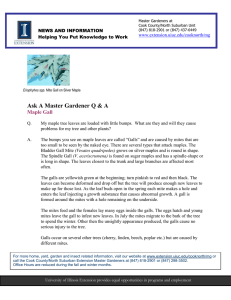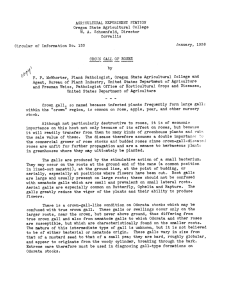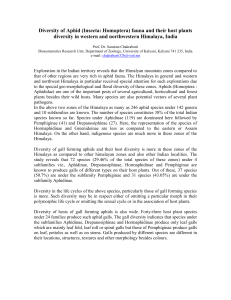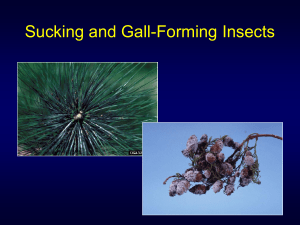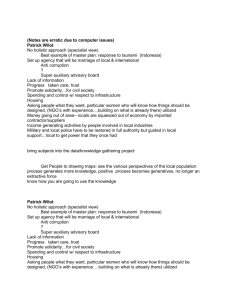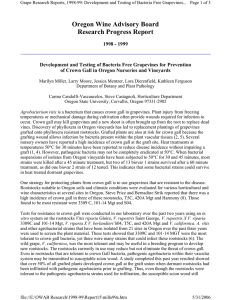Crown Gall Natalie P. Goldberg Extension Plant Pathologist
advertisement
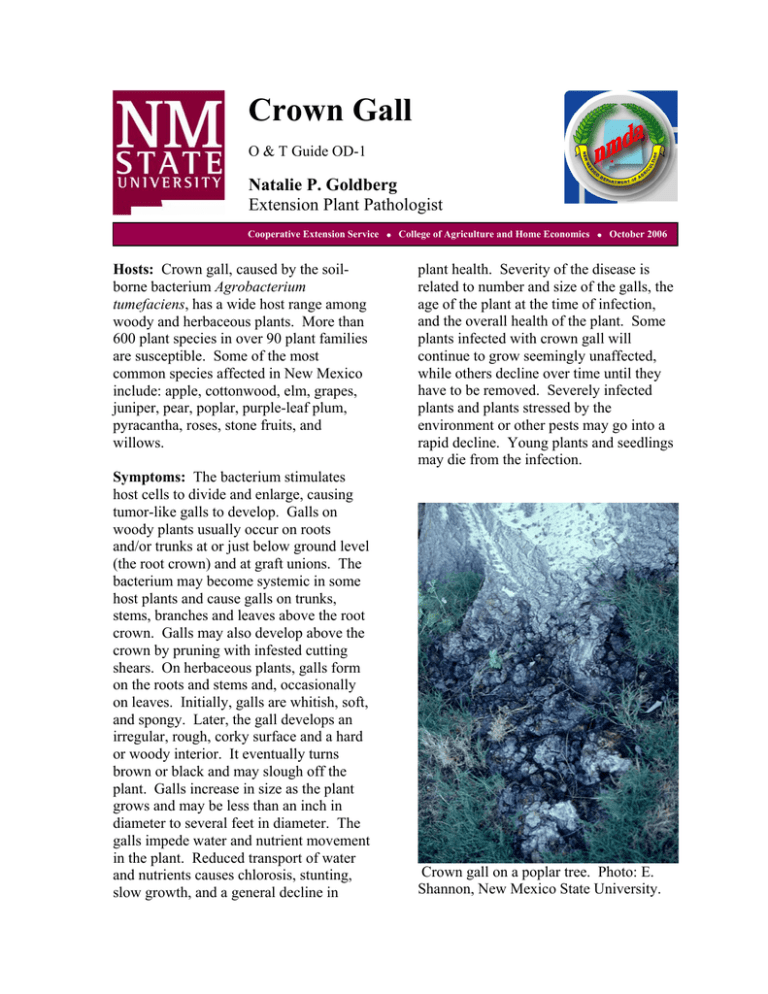
Crown Gall O & T Guide OD-1 Natalie P. Goldberg Extension Plant Pathologist Cooperative Extension Service Hosts: Crown gall, caused by the soilborne bacterium Agrobacterium tumefaciens, has a wide host range among woody and herbaceous plants. More than 600 plant species in over 90 plant families are susceptible. Some of the most common species affected in New Mexico include: apple, cottonwood, elm, grapes, juniper, pear, poplar, purple-leaf plum, pyracantha, roses, stone fruits, and willows. Symptoms: The bacterium stimulates host cells to divide and enlarge, causing tumor-like galls to develop. Galls on woody plants usually occur on roots and/or trunks at or just below ground level (the root crown) and at graft unions. The bacterium may become systemic in some host plants and cause galls on trunks, stems, branches and leaves above the root crown. Galls may also develop above the crown by pruning with infested cutting shears. On herbaceous plants, galls form on the roots and stems and, occasionally on leaves. Initially, galls are whitish, soft, and spongy. Later, the gall develops an irregular, rough, corky surface and a hard or woody interior. It eventually turns brown or black and may slough off the plant. Galls increase in size as the plant grows and may be less than an inch in diameter to several feet in diameter. The galls impede water and nutrient movement in the plant. Reduced transport of water and nutrients causes chlorosis, stunting, slow growth, and a general decline in z College of Agriculture and Home Economics z October 2006 plant health. Severity of the disease is related to number and size of the galls, the age of the plant at the time of infection, and the overall health of the plant. Some plants infected with crown gall will continue to grow seemingly unaffected, while others decline over time until they have to be removed. Severely infected plants and plants stressed by the environment or other pests may go into a rapid decline. Young plants and seedlings may die from the infection. Crown gall on a poplar tree. Photo: E. Shannon, New Mexico State University. O & T Guide OD-1 – page 2 Crown gall on juniper. Photo: E. Shannon, New Mexico State University. Crown gall on roots. Photo: APS. Crown gall on rose. Photo: North Carolina State University. Conditions for Disease: The bacterium survives in galls, on root surfaces, and in soil. It can survive years in soil in the absence of a true host by colonizing roots of non-host plants. It is spread by soil, water and in or on plants. The bacterium enters roots or stems near the ground through fresh wounds created by cultural practices environmental stresses, insects and nematodes. Any fresh wound or injury is a potential site for infection. This disease rarely kills a mature plant on its own; however, the galls weaken plants, making them susceptible to other diseases, insects and environmental stresses. Management: Once infected, there is little that can be done to help the plant other than providing adequate water and nutrients. Well-managed trees are less likely to go into a rapid decline. Other management practices which help to reduce the occurrence and severity of the disease include: ▪ Plant disease-free nursery stock. ▪ Avoid injury to roots and crown at planting. ▪ Prune properly to reduce risk of entry through improper pruning cuts. ▪ Avoid injury to ornamentals when mowing lawns or using weedwhackers. ▪ Clean pruning and other tools with 10% liquid household bleach or 70% alcohol between cuts. ▪ Dig up and get rid of (burn or place in trash) all severely infected plants. ▪ Avoid propagating from infected plants. ▪ Do not replant the same type of plant or other susceptible plant species in the infested spot for at least five years. ▪ Replant infested locations with resistant species or non-hosts. New Mexico State University is an equal opportunity/affirmative action employer and educator. NMSU and the U.S. Department of Agriculture cooperating. October 2006 Las Cruces, NM
